Versailles Palace & Gardens: Timeless Royal Beauty
Versailles demands more than a fleeting glance—it’s a journey into opulence and history. A carefully imagined guided tour transforms the palace’s overwhelming grandeur into an unforgettable experience. Skip-the-line access and expert storytelling reveal secrets even Marie Antoinette might envy. Explore Le Nôtre’s gardens where fountains and bosquets whisper tales of power, or let evening shows ignite your imagination. Seamless transport and tailored insights offer a real immersion where history dances with magic—curiosity unlocks pure wonder.
Ever felt overwhelmed by Versailles’ labyrinthine halls and sprawling gardens, unsure where to start? A Versailles palace garden tour isn’t just a visit—it’s a passport to a world where history breathes and beauty transcends time. Bypass endless queues to dive into the Hall of Mirrors’ golden glow, where 357 mirrors reflect centuries of drama, then wander secret groves where Apollo’s myths whisper through sculpted hedges. Expert guides unveil hidden chambers like Marie Antoinette’s Queen’s Hamlet, turning every moment into a carefully imagined immersion. Traverse Le Nôtre’s 800-acre masterpiece, where fountains dance to Baroque rhythms and 200,000 trees reveal stories only insiders know. Ready to trade guesswork for tailor-made magic?
- Why a guided tour is the key to unlocking Versailles’ secrets
- Step into history: The unmissable jewels of the Palace
- A royal paradise: Exploring the legendary Gardens of Le Nôtre
- The magic of water and music: Don’t miss the Versailles shows
- Plan your perfect day: A practical guide for your Versailles tour
- Beyond the golden gates: The secret world of Marie Antoinette

Why a guided tour is the key to unlocking Versailles’ secrets
Stepping into Versailles feels like entering a world where history breathes through gilded walls and manicured gardens whisper tales of royal splendor. With 700 rooms and 800 hectares to explore, the sheer scale can feel overwhelming. A guided tour transforms this vast estate into a magical journey, revealing its hidden soul—from Louis XIV’s hunting lodge to the Hall of Mirrors where history was made.
Imagine bypassing crowds while your expert guide shares secrets of the Sun King’s reign. Skip-the-line access lets you trade waiting for discovering Marie-Antoinette’s hidden grotto or admiring the Orangerie’s 2000 orange trees. This transforms sightseeing into living history, opening doors to Trianon estates few tourists reach alone.
Many tours include Paris transport, turning a commute into luxury. As your vehicle glides through Versailles’ gates, you’re already immersed in 17th-century opulence.
Go beyond the checklist: The magic of an expert-led experience
This isn’t a rigid tour—it’s a living story. Your guide transforms cold marble and tapestries into vibrant narratives. While solo visitors might miss an ordinary door, your guide reveals its passage to secret gardens where Marie-Antoinette once strolled.
These conversations adapt to your curiosity. Wonder about Versailles’ 200,000 trees? Your guide shares which species came from Louis XIV’s expeditions. Curious about daily life? They’ll describe how courtiers navigated etiquette and silver chamber pots symbolizing excess.
Skip the line, not the experience
Picture this: while others wait 2+ hours, you’re already admiring Apollo’s Chariot fountain. High season lines stretch 100 meters—priority access gains hours to explore both Hall of Mirrors and Marie-Antoinette’s hamlet. Even with security checks, you’ll avoid worst waits, gaining time to watch light dance across the Grand Canal.
For first-time visitors, this advantage transforms stress into seamless discovery. Your guide might even share how Venetian artisans crafted the Hall of Mirrors’ 357 mirrors—a detail turning architecture into adventure.
Step into history: The unmissable jewels of the Palace
The Palace of Versailles began as a modest hunting lodge built by Louis XIII in 1623, later transformed by Louis XIV into a symbol of absolute monarchy. Shaped by generations of monarchs and architects like Jules Hardouin-Mansart, Versailles became a stage where art and power intertwined.
The Hall of Mirrors: A Symbol Etched in Light
Imagine 357 mirrors reflecting sunlight through 17 arched windows, their golden frames surrounding you like a silent audience. This is the Hall of Mirrors, where history and spectacle collide. Designed by Mansart and adorned by Charles Le Brun’s celestial ceiling, it was here that Louis XIV cemented his Sun King persona, commanding awe through art.
“Here, in the dazzling Hall of Mirrors, the King demonstrated his absolute power not with words, but with an overwhelming spectacle of light, gold, and art that left every visitor breathless.”
Its grandeur hosted treaties like the 1919 Versailles Agreement, proving its enduring role in global history.
The King’s and Queen’s State Apartments: A Dance of Power and Intimacy
The King’s State Apartments unfold as a mythological narrative: the Salon d’Hercule, where François Lemoyne’s ceiling glorified strength; the Salon de Vénus and Salon de Mars, scenes of perfumed banquets and military toasts. Each salon blended luxury with political messaging. The Queen’s Apartments, home to Marie-Thérèse, Marie Leszczyńska, and Marie-Antoinette, reveal intimate dramas—public royal births, whispered court intrigues. These spaces balanced power’s display with private struggles.
Behind Closed Doors: The Private Apartments
Guided tours unlock Versailles’ hidden chambers, like Louis XV’s Cabinet des Chiens—where his hounds slept—or the Cabinet de la Pendule, housing an astronomical clock. Louis XVI’s Salle à Manger des Porcelaines, showcasing Sèvres collections, contrasts with the Bibliothèque Gabriel, a sanctuary of intellect. These rooms offer a rare glimpse into royal daily life, where kings and queens retreated from courtly glare.
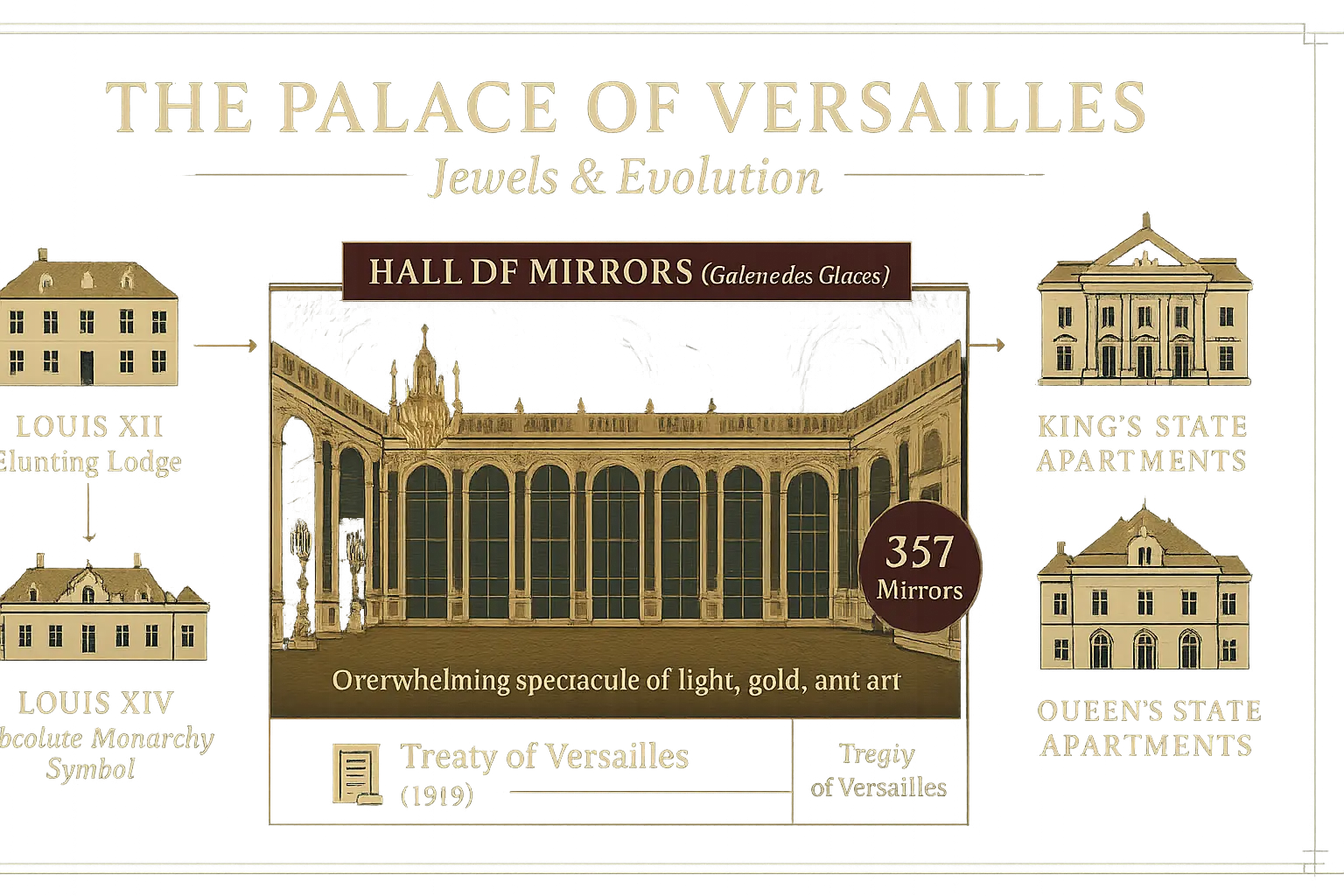
Every corner of Versailles tells a story—where history isn’t preserved but performed. Wander its halls to witness the splendor and complexity of France’s royal past, from gilded salons to intimate retreats.
A Royal Paradise: Exploring the Legendary Gardens of Le Nôtre
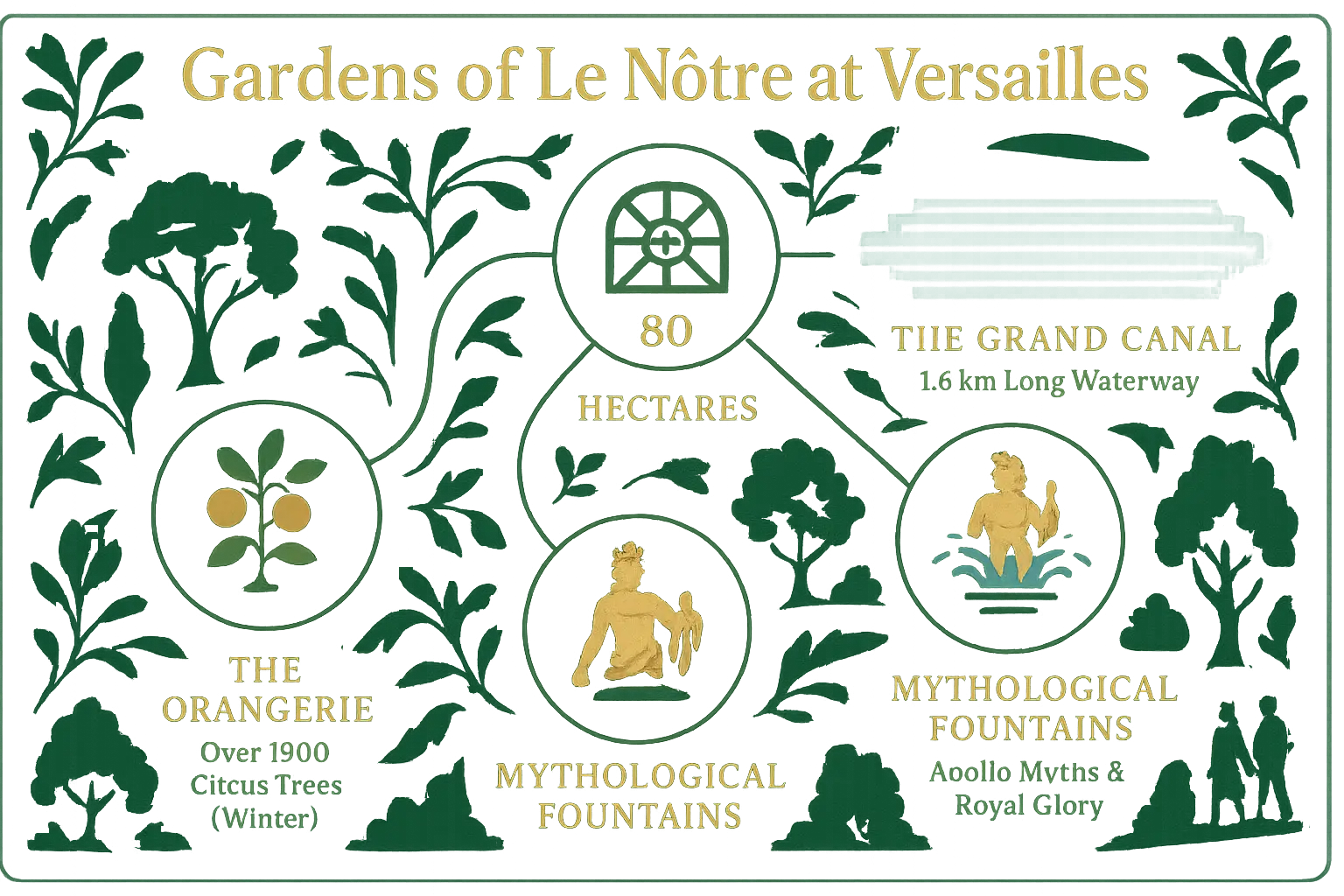
Step into a realm where nature bends to artistic mastery—a 80-hectare canvas where every hedge, fountain, and statue whispers tales of grandeur. The Gardens of Versailles, orchestrated by André Le Nôtre, aren’t just an accompaniment to the palace; they’re a symphony of power and imagination. Imagine a king so bold he reshaped the earth to mirror his divine ambition. This is where Louis XIV’s vision of absolutism meets Baroque splendor.
Where Myth Meets Majesty
Every corner of these gardens tells a story. Let’s unveil their crown jewels:
- The Orangerie: A winter sanctuary for over a thousand citrus trees, its curved glass façade once sheltered Louis’ most prized orange and lemon specimens.
- The Grand Canal: This 1.6 km sapphire ribbon hosted mock naval battles and gondola rides under moonlit skies—a liquid stage for royal pageantry.
- Latona’s Fountain: Marvel at the transformation of defiant peasants into toads, a mythic nod to Louis’ triumph over the Fronde rebels.
- The Groves (Les Bosquets): Secret garden “rooms” like the Ballroom Grove, where cascading water once accompanied the Sun King’s dances.
The Silent Language of Power
These aren’t mere decorations—they’re a coded homage to Apollo, the Sun God. Notice how jets of water arch over Latona’s sculpted frogs without touching her, symbolizing invincibility. Or how Apollo’s Fountain depicts his chariot soaring toward the sky, mirroring Louis’ self-proclaimed radiance. Even the Grand Canal’s orientation aligns with the solstice sunrise, turning the entire garden into a celestial compass.
Time Travel Through Sensory Delight
Wander paths that once cradled whispers of court intrigue. Breathe in the 210,000 seasonal blooms that paint the parterres with living color. Hear the rustle of 200,000 trees sheltering 400 mythological statues—each carved to immortalize Louis’ reign. When summer’s “Musical Gardens” transform fountains into orchestras, you’ll understand why Voltaire called this “the masterpiece of Europe.”
Ready to decode the Sun King’s ultimate power play? The gardens await—a living tapestry where history, art, and nature fuse into an unforgettable experience. All you need is curiosity and a comfortable pair of shoes.
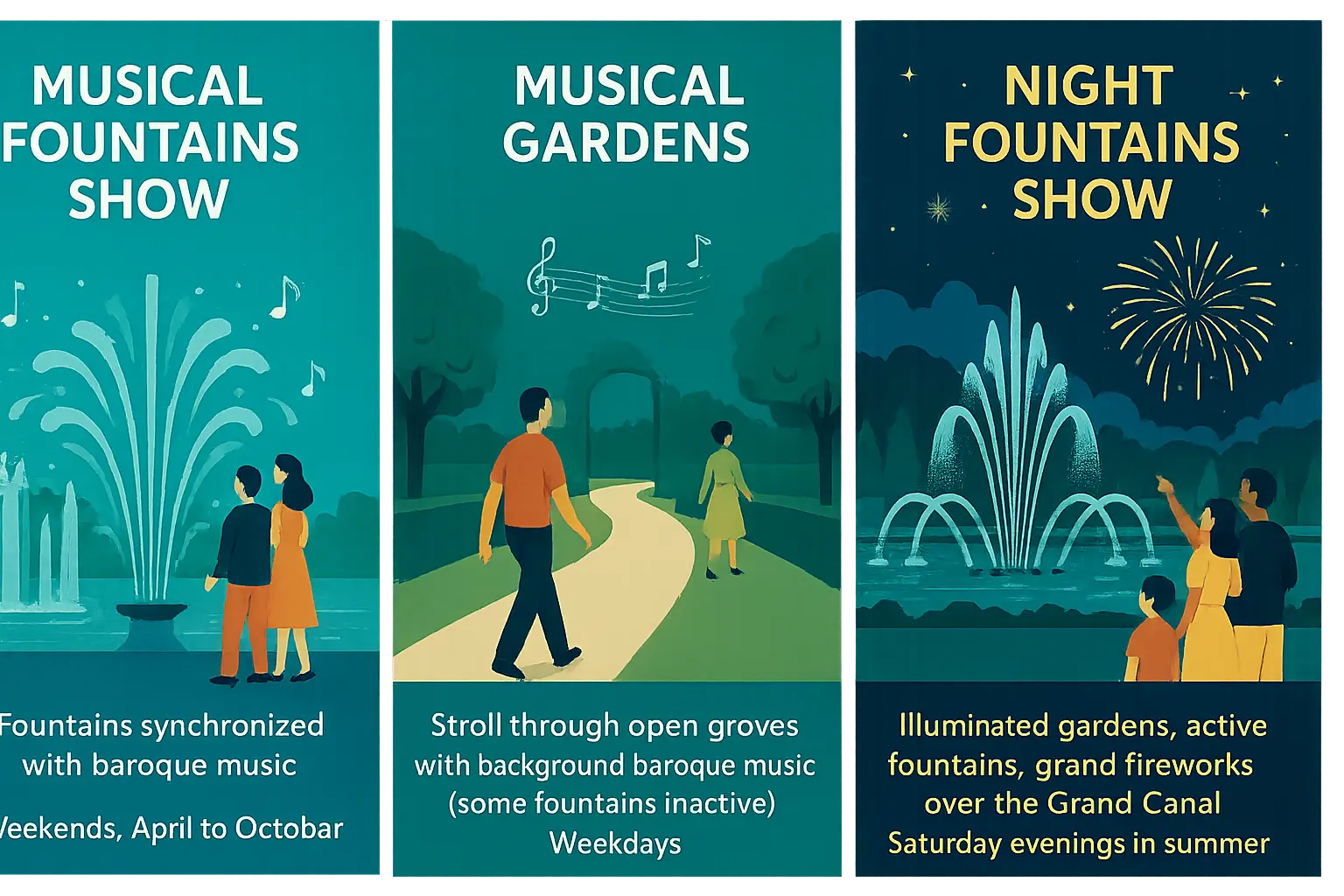
The magic of water and music: Don’t miss the Versailles shows
Step into a living canvas where Vivaldi’s Four Seasons harmonize with 600 dancing water jets across 800 acres of France’s most iconic gardens. Versailles’ musical shows aren’t mere performances – they’re time machines where 17th-century grandeur collides with 21st-century spectacle. This is Louis XIV’s vision reimagined: “L’art de surprendre,” as the Sun King would’ve declared. Every April to October, 30,000+ visitors weekly prove these aren’t just shows – they’re pilgrimage sites for art and history lovers.
Weekend Grandes Eaux Musicales transform 55 fountains into choreographed symphonies. Watch 600 jets erupt – from Neptune’s mythological drama (5-minute bursts every 15 minutes) to Colonnade’s geometric cascades. Every April-October Saturday/Sunday, Lully’s Ballet de Flore makes Apollo’s chariot shimmer. Don’t miss the 5:20 PM Neptune finale: 15-minute jet rhythms crescendo into rainbows of water and light – pure Baroque rock concert energy. History buffs adore how the 1685-inspired choreography mirrors Louis XIV’s original stagings.
For subtler magic, weekday Jardins Musicaux invite intimate exploration. Wander Salle de Bal’s hidden groves where Charpentier’s Te Deum drifts past topiary dragons. Though grand jets sleep, Théâtre d’Eau’s 10,000 droplets dance to Rameau’s Les Indes Galantes. At 9€, discover lesser-known gems like Bassin du Miroir’s 7-minute ripples – perfect for photo moments. Music lovers note: The 2025 lineup features 20+ baroque compositions, from Lully’s dramatic overtures to Campra’s maritime motifs.
As twilight gilds the Marble Courtyard gold, Grandes Eaux Nocturnes turn Versailles into a fever dream. For €33, a 2.5-hour adventure begins with illuminated bosquets glowing like Versailles’ best-kept secrets. By 22h50, the Grand Canal becomes a canvas for 10,000 fireworks – Groupe F’s pyrotechnics reflecting off water jets. Don’t miss the 20 September Electro edition where Daft Punk remixes meet baroque playlists – an unexpected fusion that’s electrified crowds since 2023.
Plan wisely: The €32 Passport unlocks hidden chambers and Trianon’s private gardens. Arrive early for the 10h30 Perspective d’Eau awakening – 150 water arcs salute the day. Remember, these aren’t shows you watch. They’re 350 years of magic, updated nightly. Pro tip: Combine with Trianon’s Belles Eaux (May-October) for a 48-hour immersion – 10€ extra grants access to Marie Antoinette’s private water features.
| Time | Activity | Pro Tip |
|---|---|---|
| 9:00 AM | Arrive at Versailles (with skip-the-line tickets) | Be at the entrance before it opens to get through security quickly. |
| 9:15 AM – 11:30 AM | Tour the Palace (Hall of Mirrors, State Apartments) | Visit the most popular rooms first before the biggest crowds arrive. |
| 11:30 AM – 1:00 PM | Explore the Gardens near the Palace (Orangerie, Latona’s Fountain) | The Musical Fountains Show often starts mid-morning, check the schedule. |
| 1:00 PM – 2:00 PM | Lunch | Pack a sandwich to eat in the park or choose one of the many restaurants (e.g., La Flottille on the Grand Canal). |
| 2:00 PM – 4:30 PM | Explore the Grand Canal & Marie Antoinette’s Estate | Rent a golf cart or take the Little Train (Petit Train) to save time and energy. |
| 4:30 PM – 5:30 PM | Final stroll through the Groves (Bosquets) | Many groves are only open on show days, don’t miss them on your way back. |
- Wear comfortable shoes: You will walk for miles. This is the most important tip!
- Pack for the weather: Bring water and sunscreen in summer, or warm layers in winter.
- Use the free mobile app: It includes an interactive map and audio guides, perfect for exploring 80 hectares of gardens.
- Check accessibility: Some areas have limited access for people with reduced mobility. Check in advance.
Plan your perfect day: A practical guide for your Versailles tour
Getting There
Reaching Versailles from Paris offers a fairytale journey. The RER C train costs €5 one-way and takes 30-50 minutes. For a luxury option, private tours (€145-€380/person) include expert guides and executive transport. Buses like Tootbus provide convenient transfers, though trains remain most travelers’ top choice.
Tickets and Opening Hours
The Palace opens daily except Mondays from 9 AM to 6:30 PM (5:30 PM Nov-Mar). Gardens stay free November-March. Book tickets in advance, especially for special tours like “The Hidden Doors” or Marie Antoinette’s Estate. The free mobile app helps navigate 200,000 trees across 80 hectares.
Best Time to Visit
Visit mid-afternoon to avoid crowds. While April-October brings lively scenes, November-March offers Musical Fountains where 600 jets dance to Baroque music. Early risers catch quiet moments in the Hall of Mirrors before 9 AM.
Optimizing Your Visit
Arrive before opening to beat security lines! Start with the Hall of Mirrors when quiet, then explore gardens as crowds grow. Discover the Encelade Fountain where water bursts from a buried giant’s mouth. Use electric carts (€42/hour) to cover 800 meters between palace and estate.
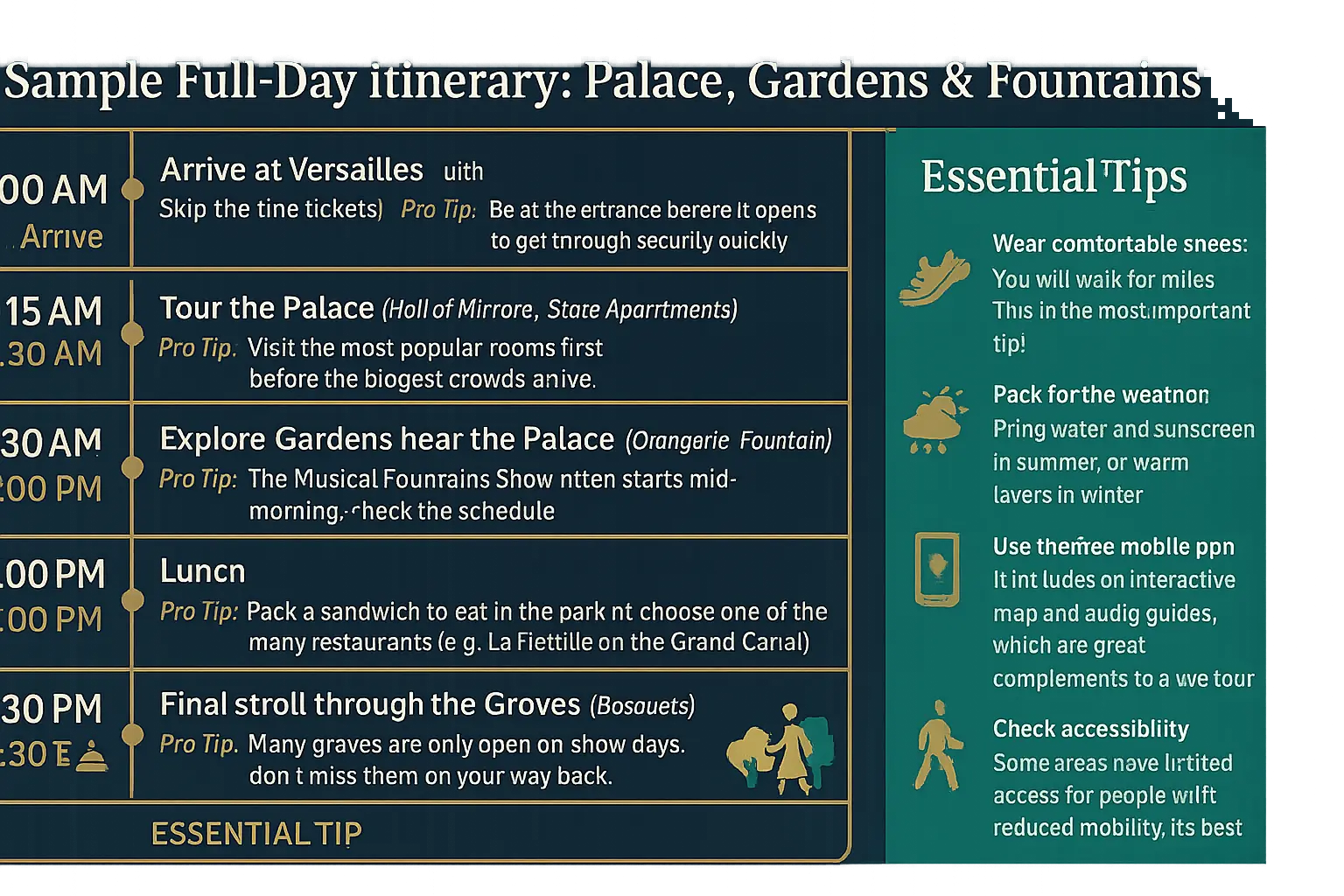
Beyond the golden gates: The secret world of Marie Antoinette
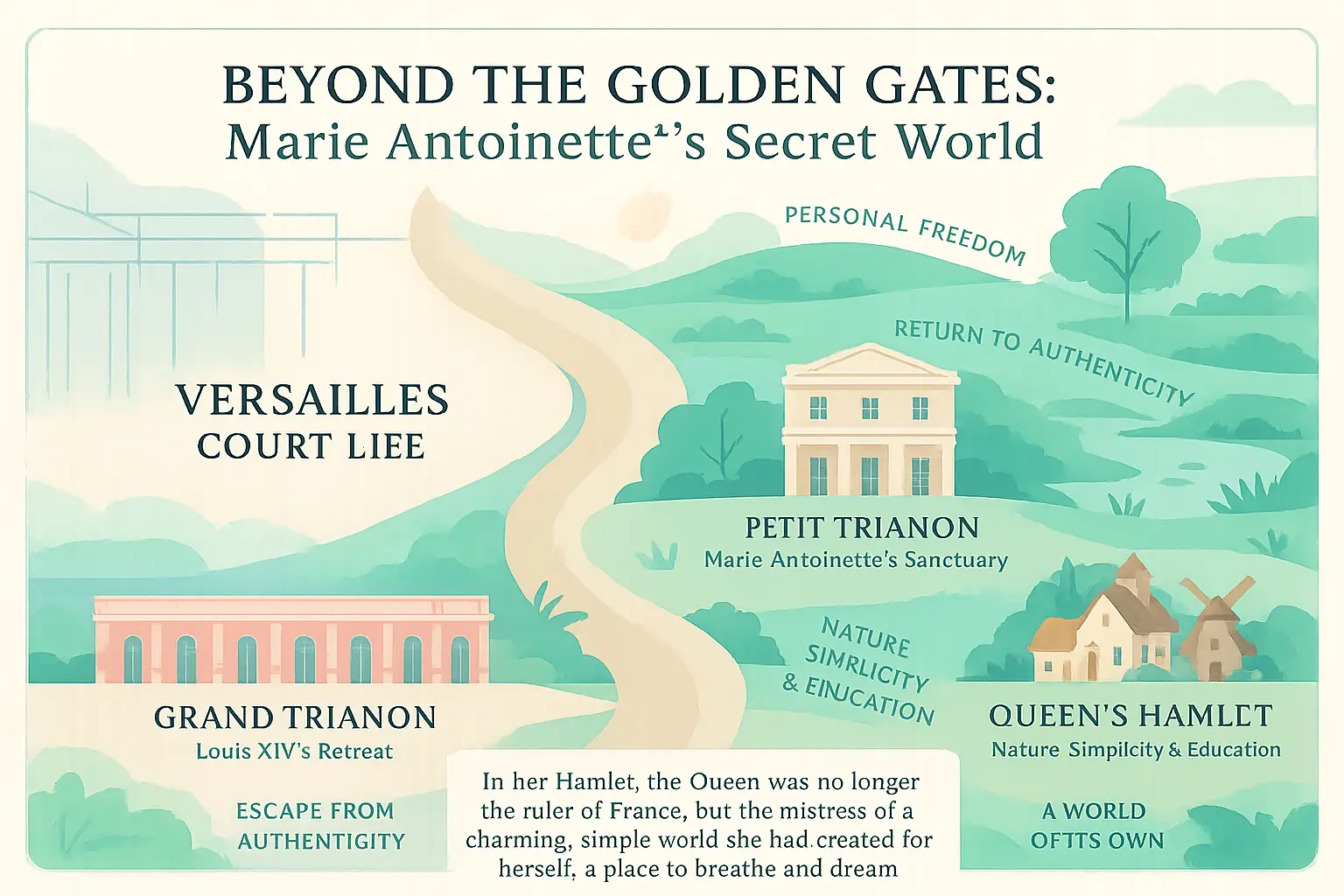
Step into Marie Antoinette’s hidden world, where Versailles transforms from gilded opulence to intimate charm. The Domaine de Trianon reveals a queen’s sanctuary—a haven of simplicity, creativity, and quiet defiance against courtly rigidity.
Grand Trianon: A retreat for kings
Built in 1687, the Grand Trianon’s pink marble façades glow as a “jewel in its own right.” Designed by Louis XIV for private escapes, its colonnaded peristyle merges courtyard and garden, a radical concept even Napoleon adopted. Today, its Empire-era interiors and floral parterres—once refreshed daily—whisper tales of monarchs seeking solace.
Petit Trianon: Marie Antoinette’s private kingdom
Gifted by Louis XVI in 1774, the Petit Trianon became her creative refuge. She replaced Louis XV’s botanical gardens with romantic landscapes of winding paths and hidden groves. Its neoclassical façade, adorned with floral motifs honoring her Austrian heritage, concealed intimate chambers where she hosted discreet gatherings, far from courtly scrutiny.
The Queen’s Hamlet: A rustic utopia
Picture a pastoral village by a tranquil lake—a bold contrast to Versailles’ splendor. The Queen’s Hamlet (1783–1786), designed by Richard Mique, blended rustic charm with royal indulgence: thatched cottages, a working farm, and a mill where Marie Antoinette donned simple dresses, taught her children nature’s wonders, and escaped her public persona—a “return to authenticity” for a queen scrutinized for extravagance.
In her Hamlet, the Queen was no longer the ruler of France, but the mistress of a charming, simple world she had created for herself, a place to breathe and dream.
Why settle for half the story? The Domaine de Trianon, included in the €32 Passport ticket, completes your journey. Stroll the Hamlet’s paths, where trompe-l’oeil facades masked the queen’s search for simplicity. Admire the Grand Trianon’s blooming parterres, once a royal floral spectacle. This isn’t just history—it’s a portal to Versailles’ human side.
Visit during the “Belles Eaux” season (May–October) to see Trianon’s fountains dance. Combine with the palace and gardens for a full-day immersion. Isn’t experiencing both sides what makes this a truly “unforgettable experience”?
Your Versailles palace garden tour transforms a visit into a timeless journey through art and grandeur. Skip-the-line access, hidden wonders, and expert storytelling reveal glittering halls, whispering groves, and the Sun King’s splendor. Embrace magic. Let history breathe. Begin your royal adventure today.
FAQ
Is it possible to visit just the gardens of Versailles?
Absolutely! The Gardens of Versailles are more than just a backdrop—they’re a masterpiece in their own right, designed by André Le Nôtre to reflect Louis XIV’s vision of order and grandeur. Open daily from dawn to dusk, they’re free to explore November through March, while summer visits (April–October) require a ticket on days with special shows like the Musical Fountains. Imagine strolling past 200,000 trees, 400 mythological sculptures, and the glittering Grand Canal—no château visit needed for this slice of paradise!
How much time should you plan for exploring Versailles’ gardens?
Give yourself 2–3 hours to wander the 80-hectare grounds, but don’t rush! The gardens are a living tapestry of art and nature, with hidden gems like the Ballroom Grove or Apollo’s Fountain waiting to surprise you. For a brisk overview, focus on the central axis near the palace. Want to dive deeper? Rent a bike or golf cart to chase distant marvels like the Queen’s Hamlet. Pro tip: pair your stroll with the Musical Gardens’ baroque melodies for an experience that “awakens your senses”!
Are the gardens part of the Versailles Palace experience?
Oh yes—the gardens aren’t just an afterthought; they’re the soul of Versailles. Louis XIV treated them as an extension of his power, where nature itself bowed to his will. André Le Nôtre’s design—equal parts art gallery and theater—uses 1.6 km of Grand Canal and 357 fountains to tell stories of gods and glory. Don’t miss Latona’s Fountain, where peasants-turned-frogs warn against insolence, or the Orangerie’s winter sanctuary of citrus trees. This isn’t a garden—it’s “a jewel in its own right.”
When can you experience the magical musical gardens at Versailles?
Let baroque rhythms guide your steps! The Musical Gardens (Jardins Musicaux) bring the groves to life with curated playlists from Tuesday to Sunday, June through October. Picture yourself gliding past the Colonnade or sipping champagne near Neptune’s Fountain as Vivaldi’s violins swirl around you. Best part? The fountains stay dry, letting you wander freely while still soaking in the ambiance. For full spectacle, return for the Musical Fountains Show (weekends) or Grand Night Fountains (Saturday evenings), where firework finales rewrite what “royal entertainment” means.
Do the Versailles gardens live up to the hype?
Let us count the ways! These aren’t just gardens—they’re a 17th-century Instagram feed of power, where every hedge and statue shouts “divine right of kings.” With 210,000 flowers refreshed seasonally and groves that transform into secret theaters during shows, they’re worth every euro (or free entry if you visit off-season!). Pro tip: Visit in early spring when the 200,000 tulips explode into bloom—your camera roll will thank you.
Is free access to Versailles possible?
You bet—but timing is everything! Slip through the gates when the gardens open at 7 AM (8 AM in winter) for free entry November–March. During warmer months, enjoy free access to park areas beyond the palace grounds any day, but save splurging for the Musical Fountains Show days (weekends April–October). Remember: the château itself requires tickets, but this is your golden ticket to Versailles’ beating heart without breaking the bank.
Does the Petit Train enhance your Versailles journey?
For some, it’s a royal cheat code! The Little Train (Petit Train) covers 7 km of gardens and Trianon estate in 35 minutes, perfect for families or fatigue-avoiding explorers. Think of it as a “tailor-made” chariot that lets you focus on beauty, not blisters. While not indispensable for the palace-adjacent groves, it’s gold when chasing the Queen’s Estate or Grand Trianon. Just don’t skip the 45-minute walk back—it’s your chance to spot hidden fountains!
When should you visit Versailles for the perfect day?
Channel your inner courtier and aim for Tuesday mornings—the gardens open early with fewer crowds, and you’ll beat summer heat. Avoid Mondays (palace closed) and French holidays like May 8th or July 14th. If you crave spectacle, Saturdays mean Night Fountains, but prepare to share the magic with 10,000+ fellow admirers. For golden-hour photos, arrive 2 hours before sunset—their light turns Versailles into a living painting.
Can you bring a backpack to Versailles?
Pack your essentials, but pack smart! Backpacks are allowed, but oversized bags (over 55x35x20cm) face security delays at palace entrances. Leave large luggage at your hotel, and opt for a chic crossbody for fountain-hopping. Pro tip: Security might ask to open your bag—no need to worry, just show you’re ready to “let yourself be surprised” by Versailles’ wonders, not held back by logistics!
